If you wear contact lenses, you may have noticed that the numbers on your contact lens prescription are not the same as the numbers on your prescription for glasses. No, this is not a mistake.There is a perfectly good reason for this, and in this article, I will explain why and how the numbers that determine the power of your contact lenses are different than the numbers that make up your glasses prescription.

Difference Between Contact Lens And Glasses Prescription
So why are they different anyway? The simple reason is because the distance between any type of lens and your eyes affects the effective focusing power of those lenses. Glasses and contact lenses are both different types of lenses, and each are used at different distances from the eye.
When your eye doctor measures your prescription, he/she is placing different lenses in front of your eyes and finding the lenses that help you see best. There is a standard distance from your eye at which all these lenses are being shown during a standard glasses prescription check. Therefore, the prescription that you get is for lenses that sit a certain distance away from your eyes. That standard distances is about 12 – 14mm.
As we all know, there is no distance between contact lenses and your eyes. Because contacts are much closer to your eyes than the lenses in glasses, they will focus light differently than glasses, and therefore must be adjusted in order for you to see clearly and comfortably through them.
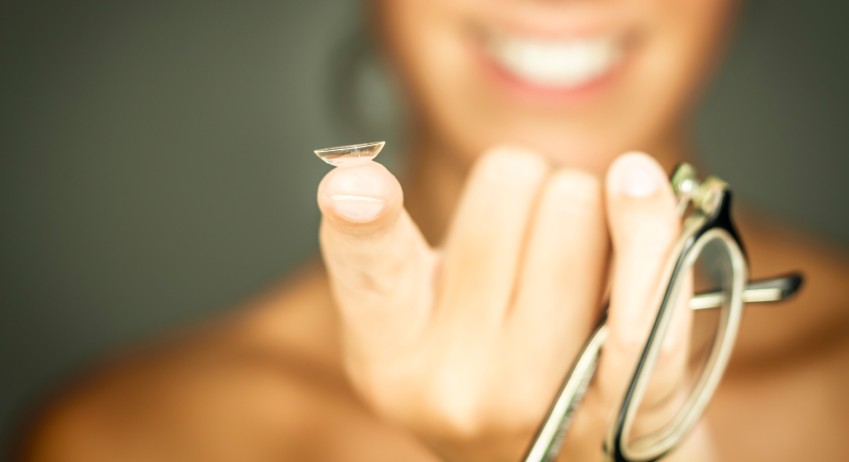
Before The Conversion
Eye doctors go through several steps to make sure that prescriptions are properly converted before fitting anyone with contact lenses. This generally involves…
- Using a conversion chart (although many eye doctors can do the calculations in their head)
- Adding/subtracting positive and negative numbers
- Taking the ‘absolute value’ of numbers
- Rounding numbers up or down based on their knowledge of what’s available in contact lenses and what’s not
Only eye doctor and other eye care professionals are qualified to covert your glasses prescription into a valid prescription for contact lenses.
Vertex Conversion Chart
A vertex conversion chart is a handy tool in the conversion process. It provides the results of a rather complex formula for all the possible ‘Sphere’ values that one could find on a prescription for glasses. A chart like this removes the need to actually work through the formula every time. It can be used to quickly look up the answers.
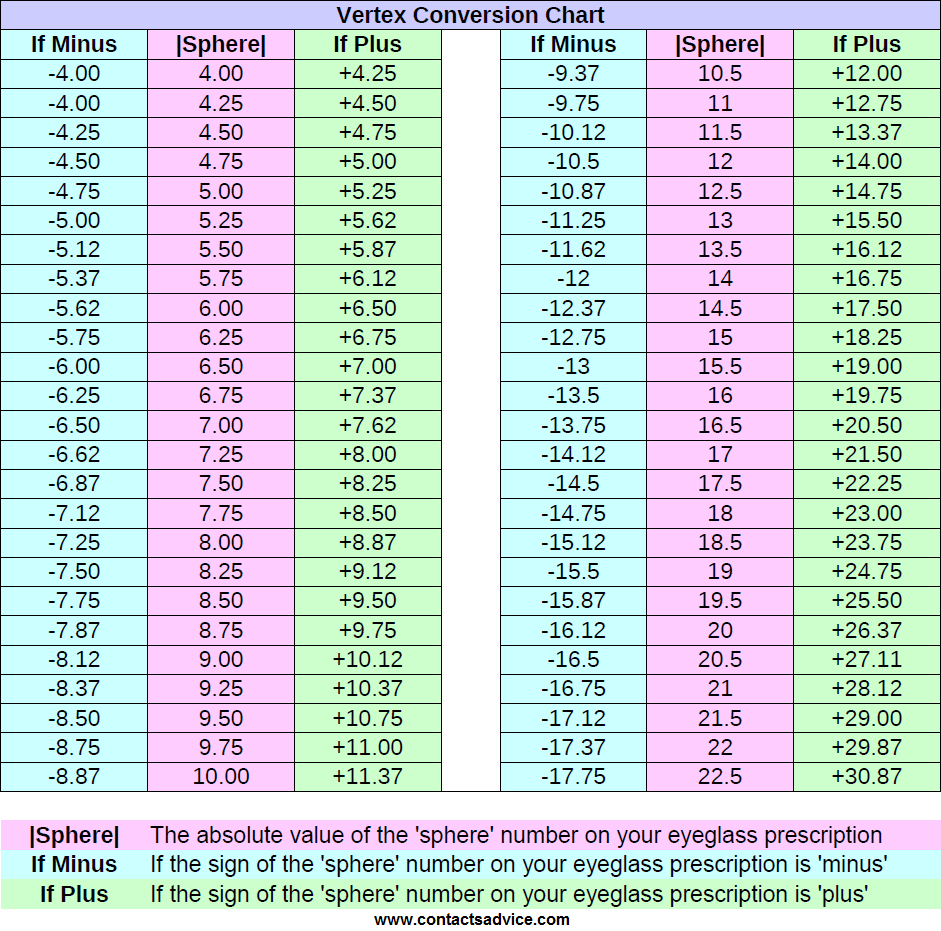
A Vertex Conversion Chart For ‘Sphere’ And ‘Cylinder’?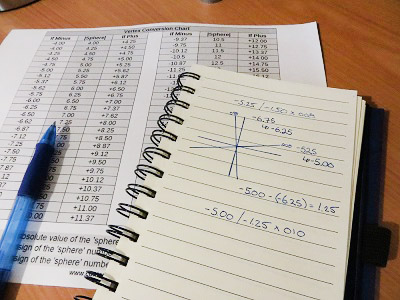
A traditional vertex conversion chart is a useful tool, but it is only a partial resource as it does not help one convert the ‘Cylinder’ number on glasses prescriptions. There are too many ‘Sphere’ and ‘Cylinder’ combinations to fit in a single chart, which is why I decided to create a series charts that can be used to easily look up the conversion for any ‘Sphere’ and ‘Cylinder’ combination.
I created these charts to save time when performing calculations on high or complicated prescriptions. Instead of having to break down the prescription and draw a power cross, followed by looking up several numbers on a traditional vertex conversion chart, then adding and subtracting the results, and finally putting the prescription back into the correct format, using these charts I was able to simply look up the combination that I need and see the answer right away.
If you routinely do back vertex calculations, feel free to use my charts as a reference, but remember that they are only useful in performing back vertex calculations. They do not provide contact lens prescriptions.
==> Click Here To Access My Vertex Conversion Charts For Both Sphere And Cylinder Combinations <==
The Conversion Process
Below is a general description of how the conversion process happens. Please note that there are many additional factors that contribute to the final result. Only your eye doctor has access to these additional factors.
Converting the ‘Sphere’ number
The first number to appear on an eyeglass prescription is the ‘Sphere’. This number denotes whether you are nearsighted (the ‘Sphere’ number will be negative) or farsighted (the ‘Sphere’ number will be positive).
- If the absolute value of the ‘Sphere’ number is 4.00 or lower, the number is left as is.
- If the absolute value of the ‘Sphere’ number is greater than 4.00, it has to be converted. To convert the ‘Sphere’ number, a vertex conversion chart is usually used.
- First, the absolute value of the ‘Sphere’ number is located in the middle column of the vertex conversion chart.
- If the original ‘Sphere’ number began with a minus sign, the number directly to the left is the back vertexed ‘Sphere’ number.
- If the original ‘Sphere’ number began with a plus sign, the number directly to the right becomes the back vertexed ‘Sphere’ number.
Occasionally the vertex conversion chart will give you a number that ends in .12, .37, .62 or .87. These numbers are not available in contact lenses. This is where eye doctors need to decide whether to round up or down to the nearest .25, .50, .75 or .00 based on different factors.
Converting the ‘Cylinder’ number
The second number in glasses prescriptions is the ‘Cylinder’. Converting this number requires some careful consideration. A simplified explanation would go something like this:
- If there is no ‘Cylinder’ number, the conversion is finished.
- If the ‘Cylinder’ number is -0.25 or -0.50, it is removed in the contact lens prescription. More on this later.
- If the ‘Cylinder’ number is -0.75 or higher, it will either remain the same (if it matches a ‘cylinder’ that’s available in the contact lens brand you’re being fitted with) or rounded up or down to the nearest available ‘Cylinder’ for your brand of contacts.
- Available ‘Cylinders’ are typically -0.75, -1.25, -1.75, -2.25, -2.75, although there are brands that have extended ranges.
- If the cylinder number is in between one of the above steps (i.e., -1.00, -1.50, -2.00, -2.50, -3.00), your eye doctor must make a decision as to which available power will work best for you (rounding up or down). Sometimes it is necessary for your eye doctor to have you try on both in order to determine which one helps you see best.
A note about ‘Cylinder’: If you have ‘Cylinder’ in your contact lens prescription, you will need to be fitted with a contact lens ‘for astigmatism‘, also sometimes named ‘toric’ contact lens.
When the cylinder is -0.25 or -0.50
Contact lenses for astigmatism only become available at ‘Cylinder’ values of -0.75 or higher. So what happens when the Cylinder on your glasses prescription is -0.25 or -0.50? Either 1 of 2 things…
- Generally, if the glasses ‘Cylinder’ is -0.25, it is not included in the contact lens prescription. -0.25 is such a small amount of ‘Cylinder’ that it does not need to be accounted for in the contact lenses. This causes the ‘Axis’ number to be dropped from the contact lens prescription as well.
- If the cylinder is -0.50, it is still dropped from the contact lens prescription, but in order to compensate for the missing ‘Cylinder’ eye doctors will adjust the ‘Sphere’ number. Removing -0.50 ‘Cylinder’ requires a compensation of -0.25 to the ‘Sphere’ number. This is called taking the ‘equivalent sphere‘ or a prescription.
Is the Cylinder Back-Vertexed?
The Cylinder number itself is never back-vertexed. However, when the ‘Cylinder’ and ‘Sphere’ numbers added together yield a value that is higher than -4.00, then that combined value needs to be back-vertexed. To re-isolated the ‘Cylinder’, the back-vertexed ‘Sphere’ needs to be subtracted from the back vertexed ‘Sphere’ + ‘Cylinder’ combination.
Honestly, it’s complicated to explain in just a sentence or two. To learn more about this process, I recommend reading my 4-part tutorial series for students on how to properly convert prescriptions.
Converting the ‘Axis’ number
In an eyeglass prescription, the ‘Axis’ number can be any number from 1° to 180°. In contact lenses, the ‘Axis’ is generally only available in 10° steps. That means that eye doctors have to determine which axis is going to give you the best vision in the contacts.
Due to the unpredictability of the fit of contact lenses for astigmatism, often times eye doctors will have to choose an initial Axis, and then refine it after he/she has seen how the lenses fits the eyes.
The higher the ‘Cylinder’ number is in a glasses prescription, the more important the ‘Ais’ becomes. For somebody with a lot of astigmatism, if the ‘Axis’ is off by even just a few degrees, it can completely throw off the vision. Only qualified eye care professionals can properly assess the fit of contact lenses on your eyes and determine what the best ‘Axis’ is for your vision.
An Example Conversion
Below is an exercise in back-vertexing. It is only meant for practicing the theoretical principles described above.
Did you get the correct answers?
Tutorials
If you’re an optician or optometry student looking for supplemental material on how to convert glasses prescriptions to contacts lenses, I have written a fairly comprehensive 4-part tutorial that can help you with this. You can find it in my ‘Conversion Resources‘ or by clicking here.
Using A Contact Lens Prescription Online
Once an eye doctor has issued you a valid contact lens prescription, you can then use it to order contact lenses in stores or online. Depending on the website you chose to buy your contact lenses from, you may or may not have to provide the website with your prescription (depending on the regulations governing the site).
Regardless of whether you have to provide your contact lens prescription or not, it is always extremely important to only use a valid contact lens prescription to order contact lenses.
Disclosure: Contacts Advice receives compensation from VisionDirect.co.uk for referring customers to them. We chose to feature VisionDirect.co.uk because of their reliable reputation and highly rated reviews. Thank you for your support.
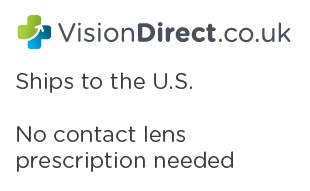
Where Can You Order Contact Lenses Without a Prescription?U.S. law requires U.S. based websites to verify that you are using a valid prescription to order your contact lenses. Other countries don’t have the same laws and can sell contact lenses without verifying the prescription. VisionDirect.co.uk is a contact lens website based in the United Kingdom that specializes in serving the U.S market. ==> Click Here To Order From VisionDirect.co.uk Without A Prescription <== |
*Note* I am not a doctor and this is not medical advice. I do not condone ordering contact lenses without a prescription. Please make sure you have been advised by your doctor before using any contact lenses.
*Note* I am not a legal expert and this is not legal advice. Please make sure you are familiar with the laws in your area regarding ordering contact lenses online.
Summary
Now you are more familiar with what goes into converting a prescription for glasses into contact lenses. And as you can see, there are many different things to consider while performing these conversions. One cannot simply apply a general formula to the numbers on a prescription for glasses, as the final results of the contact lens prescription require you to try the lenses on, and for a qualified doctor to assess the fit and vision.
Your contact lens fitting may involve several visits in order to allow you to try the contact lenses out at home/school/work before you purchase them. At the end of your visits, your eye doctor will give you a prescription that you can use to order contact lenses from anywhere they are sold.
By law, your eye doctor cannot neglect to give your prescription. For more information on the laws surrounding this rule, click here.
Where To Find The Lowest Contact Lens Prices
Once you’ve gotten everything squared out with your contact lens prescription, it’s time to start shopping around to get the best price for your contact lenses.

Here at Contacts Advice, I’ve made the process as simple as possible.
Contacts Advice is the Internet’s Best Contact Lens Price Comparison Site
Since I launched Contacts Advice in 2015, my mission has been to save contact lens wearers as much money as possible. That’s why I find the lowest prices for every brand of contact lenses so that you never overpay for your contact lenses again.
What Can You Expect From Contacts Advice?
- Price comparisons at the top 11 contact lens websites
- Lowest price found for every brand
- Weekly updates on all prices
Never overpay for contact lenses again!

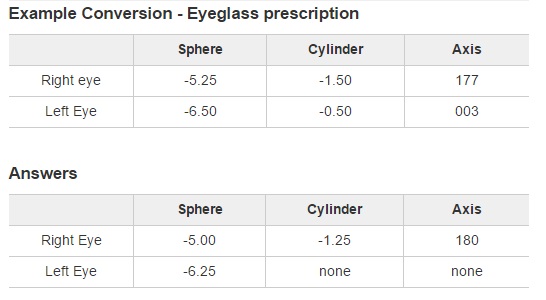

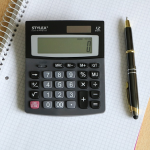
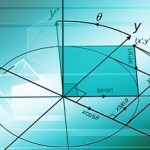

41 Responses
Dave
What about “Add”?
jayesh
hello! thanks for the information you have been sharing with us.
my glasses prescription is;
right eye- spherical=+4.5, cylindrical=+2.0, axis=90
left eye-spherical=+4.5, cylindrical=+2.5, axis=90.
I dont see an option for my cylindrical numbers, is it a mistake?
Julie
Hello Jayesh,
When the cylinder is positive, it means your prescription is written in ‘positive cylinder’ format. When you order contact lenses online, it is always in ‘negative cylinder’. To learn more about the difference between positive and negative cylinder, you can read this article.
The other thing about your prescription is that once you convert it to negative cylinder you will see that your sphere is quite highly positive. That, combined with the fact that you also have high astigmatism means that you’re going to be very limited when it comes to brands that have the parameters that you need.
It will be absolutely critical to have a fitting with your optometrist because of your complicated prescription. With numbers such as yours, there are many factors that can lead to unsuccessful contact lens if the contact lenses are not perfectly fitted.
This information is provided as an information resource only, and is not to be used or relied on for any diagnostic or treatment purposes. This information does not create any patient-doctor relationship, and should not be used as a substitute for professional diagnosis and treatment.
Glendy
I had question if my contacts prescription is -3.00 what would be my glasses prescription
Julie
Hello Glendy, the short answer is that it is impossible to know.
I have written extensively about why in this article, which I recommend you take a look at :)
This information is provided as an information resource only, and is not to be used or relied on for any diagnostic or treatment purposes. This information does not create any patient-doctor relationship, and should not be used as a substitute for professional diagnosis and treatment.
Rose
I understand you can’t prescribe. I couldn’t follow chart. My son recently got eye glass rx and the dr. forgot to do contact fit. It is simple eyeglass of -100 for both eyes. He lives in a different state and doesn’t want to go again. Wants contacts for winter sports. Do you have a chart for this conversion?
Julie
Hi Rose. When the prescription for glasses is -1.00 in both eyes and there is no astigmatism, there is no conversion to perform to get the theoretical contact lens power.
However, please be advised that does not mean the contact lens prescription would be the same as glasses. There are other things that could cause it to be different, which only your eye doctor could tell you.
When ordering contact lenses you should always do so with a valid contact lens prescription.
This information is provided as an information resource only, and is not to be used or relied on for any diagnostic or treatment purposes. This information does not create any patient-doctor relationship, and should not be used as a substitute for professional diagnosis and treatment.
Julie
Hi Courtney! Good question. The reason why there are no charts for numbers that low is because in general there is no need to convert prescriptions where the numbers are less than -4.00. You’re lucky that your numbers are so low! Hope that helps :)
This information is provided as an information resource only, and is not to be used or relied on for any diagnostic or treatment purposes. This information does not create any patient-doctor relationship, and should not be used as a substitute for professional diagnosis and treatment.
Megan Lingerfelt
I’m so confused and frustrated! Attempting to try contact lenses And failing miserably. I thought that’s ok I will finally have my prescription so if I find contacts are not for me I will be able to get some cheap Rx glasses online. Now finding out I CANT USE THAT PRESCRPTION!! ugh!! please help! my prescriptionas shown on my contact lense case says..
RIGHT; PWR -1.00 BC 8.7 DIA 14.5 CYL -0.75 AX 090
LEFT; PWR -0.75 BC 8.7 DIA 14.5 CYL -1.75 AX 050
I need help converting so i can get a pare of glasses for myself. please if someone can help it would be greatly appreciated.
Julie
Hi Megan, if I understand correctly, you have a prescription for contact lenses but you don’t have a prescription for glasses? If so, I’m afraid there’s really no other option than to return to your eye doctor for your glasses prescription. You see, a glasses prescription can be converted into a contact lens prescription by an eye doctor, but a contact lens prescription cannot be converted into a glasses prescription, not even by a doctor. There are several reasons for this which you can read about here if you’re interested. I’m sorry for your frustration you’re experiencing with all of this :(
This information is provided as an information resource only, and is not to be used or relied on for any diagnostic or treatment purposes. This information does not create any patient-doctor relationship, and should not be used as a substitute for professional diagnosis and treatment.
Julie
Hello Karina, are those numbers your glasses prescription or your contact lens prescription? In your comment, you asked about your eye glasses prescription. Can you clarify? Thanks :)
Anna
My insurance is such that I can only get one exam and contacts exam costs extra out of pocket. I opted to get a glasses one since I wear those most often but would like to get some contacts for special occasions, swimming, etc.
My glasses script reads:
OD sphere -2.50
OS sphere -3.00
In the cyl box I have the words “sph” for both eyes (no numbers in any other boxes).
An additional line says “type: DVO”
So it seems I have a pretty straight forward script – no cylinders/axis or anything else to consider.
Can I then just get contacts that are -2.50 & -3.00 without any further conversion? I’ve worn contacts for years so I already know my BC/Diameter.
Thank you for your help.
Julie
Hi Anna,
Strictly from a perspective of whether or not those powers need to be back vertexed (converted) from glasses to contact lenses, the answer is no. When the numbers are less than -4.00, moving from glasses to contact lenses doesn’t make a significant difference in the power that’s needed so it’s usually the same between glasses and contacts.
There are however, other reasons why eye doctors might want to adjust the powers, usually having to do with how well you feel and how well you can see with them. A contact lens prescription is more than just a vertex conversion (or lack thereof) so I cannot say what you should or shouldn’t order.
Hope that helps :)
This information is provided as an information resource only (i.e., not medical advice) and is not to be used or relied on for any diagnostic or treatment purposes. This information does not create any patient-doctor relationship, and should not be used as a substitute for professional diagnosis and treatment.
Destiny
Ok I’m am so confused my right sph(-0.50) cyl. (0.50) axis.(175) and left sph(-0.75) cyl.(-0.50) axis(005) what number would I put in if I wanted to order contacts online.
Julie
Hi Destiny, well that depends on where you those numbers are from. My guess is that you are reading the numbers from your glasses prescription since contact lens prescriptions don’t usually have an axis number that ends in ‘5’ and cylinders can’t be less than -0.75.
If you haven’t had a contact lens fitting with an eye care professional, I would start there. Otherwise, ask your doctor to issue you a prescription for contact lenses (which you will need to order contact lenses online).
When you’re ready to order, remember to consult Contacts Advice’s homepage for a table of where to find the lowest price for every contact lens brand.
Hope that helped :)
Julie
Hi Michelle,
In general, when the Cylinder is only -0.25, doctors will ignore it and prescribe only the Sphere. This is because a Cylinder of -0.25 is so small that it barely affects the vision, and for that reason, contact lenses are not made with Cylinders that low.
With that said, every person is different, and there may be reasons why your doctor may want to adjust the sphere. Your doctor will review all the pertinent information and let you know.
Hope this helped.
This information is provided as an information resource only (i.e., this is not medical advice) and is not to be used or relied on for any diagnostic or treatment purposes. This information does not create any patient-doctor relationship, and should not be used as a substitute for professional diagnosis and treatment.
JKHR
Hi Julie,
I just got prescriptions for both glasses & contacts. I filled both prescriptions from separate online vendors. My contacts seem to be correct – I can see well and I am not having headaches. However, my glasses seem to be waaay too strong. I can’t see with them & fear I would get a headache if I tried to wear them for any length of time. The 2 prescriptions are almost identical. Also, it has been about 5 years since I had a pair of glasses.
Normally, I would simply ask my doctor to double check my glasses prescription, but A) he is 5 hours away, & B) he recently had a major heart attack! (I did call & speak with his wife, which is how I learned of the heart attack, but she couldn’t really tell me anything about my prescriptions other than that there was no transcription error between my case file and my typed prescriptions.)
Can you tell, just by looking at the 2 prescriptions, if the problem lies with the prescription being wrong, (doctor error), or the glasses being wrong, (vendor error), or even if it’s just me having to get used to wearing glasses again? Here are my prescriptions:
Glasses:
Right SPH -4.25 CYL -2.75 Axis 010
Left SPH -4.25 CYL -2.75 Axis 170
Contacts:
Right SPH -4.25 CYL -2.75 Axis 010
Left SPH -4.00 CYL -2.75 Axis 170
Base curve = 8.6, Diameter = 14.5 in each eye
Thanks!
Julie
Hi KJHR,
Interesting situation. I can think of a couple of possibilities, all of which are simply speculation based on the details you provided and of course, is not meant to be or replace professional medical advice.
Possibility 1:
The symptoms you are experiencing with your new glasses are due to a significant difference between your old and new glasses, i.e., your eyes/visual system are not used to your new glasses.
This commonly happens when:
Possibility 2:
It is not uncommon for online glasses vendor to churn out glasses that don’t adhere 100% to prescription used to order them with. It could be that your glasses simply don’t have the correct prescription in them. To verify this you would need to take your glasses to a place that has the equipment needed to measure the strength in lenses.
Possibility 3:
Your eye doctor measured your prescription wrong. You confirmed that there was no transcription error in your prescription, but that doesn’t rule out an error made while your prescription was being measured. Prescription checks are not 100% fool-proof and sometimes errors do happen. Even the best of optometrists can occasionally get a prescription wrong since the results do – to a certain extent – depend on the answers provided by the patients. When this is the case, your eye doctor typically re-measures your prescription at no cost.
In a nutshell, those are possible reasons I can think of.
The fact that you see well with your contacts and not your glasses is not surprising in this case. Contact lenses eliminate a lot of the distortions and visual aberrations created by glasses, making vision seem much more natural with contacts. This is particularly evident for prescriptions such as yours with fairly significant numbers.
I hope your eye doctor pulls through and makes a full recovery.
Please let me know how your situation unfolds. I hope this helped :)
This information is provided as an information resource only (i.e., this is not medical advice) and is not to be used or relied on for any diagnostic or treatment purposes. This information does not create any patient-doctor relationship, and should not be used as a substitute for professional diagnosis and treatment.
JKHR
Thank you for your prompt reply. Your insight about varying points of accuity, (alignment to my visual axis), is very astute. If I end up sending the glasses back to be remade, I will make sure to mark exactly where the center of my pupils lie in relation to the glasses on my face. Pupillary distance only approximates this.
Also, I didn’t realize until your reply that I didn’t make myself clear in my initial question. For the past 5 years I have been wearing contacts only. I updated my contacts prescription at least twice during that time, but hadn’t bothered with any glasses. I was/am unsure if not having ANY glasses for such a long time would affect a “break-in period” for getting used to them again.
I kind of lean towards my doctor having gotten the glasses prescription wrong, as my contacts prescription would be significantly different if you back into it using the Vertex Conversion Chart and my current glasses prescription. But I will take the glasses to a LensCrafters or similar and have them checked and then proceed from there.
Again, thank you for your prompt response. You have given me several possibilities to explore before I have to bother my recovering doctor. (From what his wife/receptionist said, he’s doing well, but will be away about 3 months. He’s in single practice and has “floaters” coming in & keeping his practice going, but since I have to travel so far to see him, I might as well wait to see HIM. If I wanted a stranger, I could go to anybody locally!)
Julie
You’re welcome :)
I’m glad I was able to provide some useful insight into your situation.
If you’d like to discuss anything else, just drop me another message :)
Dina
Hi Can you help me with my contacts prescription? Can you indicate which is for the right eye and which is for the left eye. I have astigmatism.
OD- 0.25 – 1.75 x 180
OS- 0.25 – 1.75 x 175
Julie
Hi Dina,
OD is the right eye, and OS is the left eye.
This information is provided as an information resource only (i.e., this is not medical advice) and is not to be used or relied on for any diagnostic or treatment purposes. This information does not create any patient-doctor relationship, and should not be used as a substitute for professional diagnosis and treatment.
Julie
Hi Sarah, It’s hard to say exactly with your numbers, but a reasonable starting point could be:
R -3.50
L -3.75
To arrive at these numbers I simply applied the principles explained in this article. In my experience, that’s what most eye doctors would use a starting point for you, and adjust things as needed from there.
The b.c and dia are usually specific to your brand, meaning that you don’t really have a choice because there’s only 1 option. Sometimes you will have brands that offer 2 different b.c, in which case you need to find out from your eye doctor which one is more appropriate for you. Only your eye doctor has the information to make that determination.
Hope that helped :)
…and as always, this isn’t meant to be medical advice and I am not prescribing you contact lenses.
Sarah
Completely understood! The formula was a little difficult for me but thank you so much!
Ana
Hey, so I recently got my first pair of glasses, and my prescription was on the right -0.25 and the left was -1.00, I also got a contact lense exam but I could have sworn when they gave me the trial contacts to try on for two weeks it had the number -2.00 for my left and -0.50 for my right, but again I’m not sure cause it was my first time ever getting contacts and glasses. Well I walked out with the contacts (which were the trial ones) that day and never knew what the prescription was, however when I went back for the fitting two weeks ago they gave me the prescription for the contacts it said -1.0 on the left and -0.50 on the right. When I walked out and got the prescription, I told the lady she had my wrong age and they actually had my whole Birthdate and address wrong in their system. Which then came to my thought what if they accidentally messed up my contact lense prescription cause I thought I had seen the numbers -2.00 on the left but then again I don’t know. My contact lense prescription was on both eyes BC:8.40, Dia: 14.00, Cylinder: SPH and on the left sphere it is -1.00 and right sphere it is -0.50, again my glasses prescription is on the right -0.25 and left -1.0 I just want to make sure if it’s a normal prescription since my contacts are too be shipped soon, and if the prescription is wrong then I can return them. Thank you!
Julie
Hi Ana,
First of all, welcome to the world of wearing glasses and contact lenses :)
Based on what I know, the numbers seem normal to me. Here is my thinking:
When numbers such as the ones on your glasses prescription are present, the numbers for contact lenses are usually the same. Meaning, the most common scenario would be that both your glasses and contact lens prescription would be:
R Sphere -0.25
L Sphere -1.00
However, -0.25 is a very small power, and some contact lens brands don’t even make that power because it’s so insignificant. A lot of daily brands of contact lenses are only available in powers starting at -0.50, which is why I suspect that that’s the power you ended up with for your right for the contact lenses. Does that make sense? Were you prescribed daily contact lenses?
Regarding the trial pair that you had, I have no idea what’s going on there. If in fact, you had -2.00 for your left eye, that would be double the strength that you need, which to me, seems wrong. But that’s not the final power that you were prescribed, so I guess it’s ok?
Hope this helped :)
This information is provided as an information resource only (i.e., this is not medical advice) and is not to be used or relied on for any diagnostic or treatment purposes. This information does not create any patient-doctor relationship, and should not be used as a substitute for professional diagnosis and treatment.
Julie
Hi Mae, good day to you too!
The numbers you wrote seem incomplete to me…
A prescription for glasses typically have 3 sections known as sphere, cylinder and axis.
For your left eye you wrote -1.50. Is this for the sphere or cylinder?
For your right eye, you wrote -1.50, which again, could be sphere or cylinder.
Deb
Okay. Here is what I have:
OD +125 sphere, -025 cylinder, add +225 axis 075 right eye is dominant
Os +125 Sphere, -050 cylinder, add +225 axis 095
So
O+125 corrected for vision distance only
Os +125 +225 for reading prescription with mutlifocal lense non dominant eye
Does this make sense.
Julie
Hi Deb,
Where those contact lens numbers prescribed to you?
Since you’re wearing a multifocals, how well you will see will all depend on how good your visual system is at selectively ignoring blur, and what your preferred reading distance is.
For that reason, I don’t think you will know what works best for you until you’ve tried it. With multifocal contact lenses, an appropriate trial period monitored by your eye doctor is very important.
This information is provided as an information resource only (i.e., this is not medical advice) and is not to be used or relied on for any diagnostic or treatment purposes. This information does not create any patient-doctor relationship, and should not be used as a substitute for professional diagnosis and treatment.
kailee
hello, i have a prescription for contact lenses… im wondering if you could help me figure it out so i can order some new glasses!!
OD – Sphere -3.75 CLY -.75 AXIS 110
OS – SPHERE -4.25 CLY -.75 AXIS 070
also wondering what the OD OS are. like obviously left and right, but stands for what?
also i have astigmatism. on the side he wrote BC = 8.7 amd Dia = 14.5 dont know what those mean either.
thanks in advance!!
Julie
Hello Kailee,
OD and OS are abbreviations of the latin terms for the right eye and left the eye.
OD = oculus dextrus
OS = oculus sinister
BC and Dia are abbreviations for 2 important contact lens parameters.
BC = base curve
dia = diameter
Now, to your main question, unfortunately, there is no way of using your contact lens prescription to accurately determine your glasses prescription. The reason for this is that a contact lens prescription starts with a prescription for glasses, but is then simplified in a few different ways. Once a glasses prescription has been converted to a contact lens prescription, certain information about the original glasses prescription is lost, or ‘deleted’. You can read more in-depth into this by reading this article.
There are dozens and dozens of different glasses prescriptions that would yield your exact prescription for contact lenses, but there is nothing to tell us which one yours would be. Unfortunately, the only way for you to obtain your glasses prescription at this point would be to contact your eye doctor’s office and ask them for it.
This information is provided as an information resource only (i.e., this is not medical advice) and is not to be used or relied on for any diagnostic or treatment purposes. This information does not create any patient-doctor relationship, and should not be used as a substitute for professional diagnosis and treatment.
Parker
This is has been so helpful! I have misplaced my glasses prescription, but have my contact rx on hand: Power: -01.25 BC: 8.7 DIA: 14.0 in both eyes. Can you help me figure out what my glasses numbers would be? Thanks in advance!
Julie
Hi Parker, unfortunately, prescription conversions are a one way street from glasses to contact lenses. The process cannot be reversed to go from a contact lens prescription to glasses prescription. Here is an article that will explain why in depth.
For now, let me just say that a contact lens prescription is a modified version of glasses prescription and during the conversion process, some information is lost. Once you have a finalized contact lens prescription, you can never know 100% what the original glasses was.
Your contact lens prescription is fairly simple, but there are hundreds of different glasses prescriptions that all could have resulted in your contact lens prescription. Without any prior knowledge of your glasses prescription, it is impossible to know exactly what it is.
The best way to make sure you order precisely the glasses that you need would be to contact your eye doctor’s office and ask for it.
Hope this helped.
Julie
Hi Tina,
Applying the principles laid out in the article to those numbers, we would get:
R -4.25
L -4.00 -0.75 x 030
Add +1.50
Of course, these numbers would only serve as a starting point for further refinement by your eye doctor, especially if you’re interested in getting multifocal contact lenses.
The +1.50 add in your prescription means that if you don’t get multifocal contact lenses, you will have some difficulty reading with your contact lenses on (in the absence of reading glasses or other devices).
Hope this helped :)
Note: I am not a doctor and this is not meant to or to replace professional medical advice. You are not being prescribed contact lenses.
Julie
Hi Wulan,
What I think most eye doctors would do with those numbers is start with the spherical equivalent…
Right: Sphere -2.75 Cylinder none Axis none
Left: Sphere -3.00 Cylinder none Axis none
… and go from there. Back-vertexing those numbers is not necessary, so there isn’t really much else to do.
Please note that I am not a doctor and that you are not receiving medical advice, nor are you being prescribed contact lenses on this site.
Nicolefay
Could you please tell me what the vertexed numbers would be for:
Right == – 5.25
Left == – 4.75
Julie
Hi Nicolefay,
This chart shows us that the vertexed numbers would be:
R: -5.00
L: -4.50
Keep in mind that vertexing numbers on your glasses prescription is not sufficient to order contact lenses. There are other factors which can sometimes prompt your eye doctor to make further changes to these numbers.
Always use a valid contact lens prescription when ordering contact lenses.
Hope this helped :)
This information is provided as an information resource only (i.e., this is not medical advice) and is not to be used or relied on for any diagnostic or treatment purposes. This information does not create any patient-doctor relationship, and should not be used as a substitute for professional diagnosis and treatment.
Irene
What type of contacts would work for me if my eye glass prescription is:
OD +3.00 -025 150 Add 250
OS +3.00 DS Add 250
Thank you
Julie
Hi Irene,
Your glasses prescription indicates that you are farsighted and that you have a stronger prescription for reading that you do for distance viewing. The contact lenses you should be looking into will depend on what viewing distances you want to be clear when wearing your contact lenses.
If you only want to see clearly in the distance, you will have the most options, as any spherical brand could potentially work. However, this means that in order to see clearly up close, you’ll most likely need to wear reading glasses.
If you want to be able to see clearly in the distance as well as up close, you should look into multifocal contact lenses. If this is the case, finding the right prescription for multifocal contact lenses can be rather tricky, so a visit to the eye doctor would definitely be in order.
Hope this helped :)
This information is provided as an information resource only (i.e., this is not medical advice) and is not to be used or relied on for any diagnostic or treatment purposes. This information does not create any patient-doctor relationship, and should not be used as a substitute for professional diagnosis and treatment.
Julie
Hi Laura,
Those numbers are lower than -4.00 in both the Sphere and (Sphere + Cylinder) meaning that the back vertex formula would not change the values.
For that reason, if you went for a contact lens fitting, it is reasonable to expect that your eye doctor would start with the same numbers as your glasses for your first contact lens trial, and from there adjust the numbers if your vision wasn’t adequate for whatever reason.
Also note that since your Cylinder is -2.75, you will most likely be restricted to monthly contact lenses for astigmatism, as daily contact lenses for astigmatism tend to only correct up to -2.25.
Hope this helped :)
This information is provided as an information resource only (i.e., this is not medical advice) and is not to be used or relied on for any diagnostic or treatment purposes. This information does not create any patient-doctor relationship, and should not be used as a substitute for professional diagnosis and treatment.
Julie
Hello Zelina,
Unfortunately, I cannot give contact lens prescriptions, as only your eye doctor can do that.
Your numbers are interesting, and I think you may benefit from trialing a few different combinations of contact lens powers.
Your Sphere numbers are just at the limit of where the back vertex formation makes a difference.
Your (Sphere + Cylinder) values are higher than -4.00 for both eyes. which means that they would be affected by the back vertex formula.
If you apply the formula to your numbers you would get:
OD Sphere -4.00 Cylinder -0.25 Axis 080
OS SPhere -4.00 Cylinder -0.50 Axis 110
Of course, contact lenses are neither available in -0.25 or -0.50, so some additional manipulations would have to be performed.
Your eye doctor would probably have you trial either a -4.00 or a -4.25 for your right eye to see which one you see better with, and for your left eye, it’s not clear whether you’d see better with a toric or a spherical contact lens…
I would recommend seeing your eye doctor so that he/she can have you try and test different powers and prescribe the combination that would work best for you.
Remember, I am not a doctor and this is not to be taken as medical advice, or a substitute for professional medical advice.